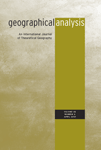A Geostatistically Weighted k-NN Classifier for Remotely Sensed Imagery. 遥感影像的地统计加权k-NN分类器研究
Abstract
enThis study aims to increase the accuracy with which remotely sensed data can be used to generate thematic maps of land cover classes. It explores the use of geostatistical models to characterize the inherent spatial variation between different land covers (woodland, rough grassland, managed grassland, and built land) and integrates these into a supervised, nonparametric, k-nearest neighbor (k-NN) per-pixel classifier. The study defines three geographical weighting methods, two of which are based on geostatistical functions. These produce a geographical weighting that is incorporated into two pure k-NN classifiers (inverse distance weighted and difference distance weighted) using a scheme that allows the weights for the information from feature space and geographical space to be varied. The relative merits of the enhanced approach are explored using a spatially and spectrally variable IKONOS subscene. Compared with the original k-NN classifications, which use only the information in the spectral response of pixels treated independently, a statistically significant increase in the overall accuracy was achieved, particularly for land cover classes with considerable within-class variation and between-class confusion.
Abstract
esEl presente estudio busca incrementar la exactitud de los mapas temáticos de uso y cobertura de tierras obtenidos en base a datos satelitales. Para dicho fin, los autores investigan el uso de modelos geoestadísticos para caracterizar la variabilidad espacial inherente entre categorías temáticas (bosques, pastos naturales, pastos manejados, áreas construidas) y los incorpora a un algoritmo de clasificación supervisado, no-paramétrico, aplicado a cada pixel, que utiliza la regla K de vecino más próximo (k-NN). El estudio define tres métodos geográficos de ponderación (cálculo de pesos), los cuales son integrados a dos algoritmos k-NN convencionales (pesos por distancia inversa-IDW y distancia diferenciada -DDW). Esta integración se realiza vía un esquema que permite variar los pesos de la información temática (espectral) y geográfica. La evaluación del método propuesto se llevo a cabo mediante una imagen IKONOS que cubre una porción menor del área de estudio total, y que varía espacial y espectralmente. Los resultados muestran que la incorporación de pesos vía métodos geoestadísticos produce un incremento general estadísticamente significativo en la exactitud temática de os mapas, en comparación a los métodos k-NN convencionales, los cuales hacen uso únicamente de la información espectral. Dicho incremento es particularmente notorio en las categorías o clases que presenta variación interna y son fácilmente confundidas con otras.
Abstract
zh本研究旨在提高应用遥感数据生成土地覆盖类型专题图的精度,探讨了采用地统计模型表征不同土地覆盖(林地,高低不平的牧草地,人工草地和建设用地)类型间的内在空间变化,并将其整合为监督的、非参数的k级最近邻距离(k-NN)的单像素分类器。研究中定义了三种地理加权方法,其中的两种基于地统计函数。采用能反映特征空间和地理空间变化信息的权重方案,形成了可融入两个纯k-NN分类器(反负距离加权和差分距离加权)的一种地理权重方法。采用空间和光谱均可变的 IKONOS次幅影像探讨了这一增强方法的优点。和仅仅利用了对像元独立处理后单纯的光谱响应信息的原始k-NN分类器方法相比,在整体精度上,新分类器在统计意义有显著提高,尤其适用于具有相当大的类内变化和类间混合的土地覆盖类型分析。




